Experimental Study on Tunnel Bottom Deformation Trend in Gently Inclined Layered Shale Based on the Energy Index
Abstract
:1. Introduction
2. Project Overview
3. Experimental Program
3.1. Specimen Preparation
- (1)
- The standard specimen was directly wrapped with plastic wrap as a natural specimen (with a water content of 2.4%).
- (2)
- The standard specimen was placed in a dryer, and the drying temperature was kept constant at 105 °C. After drying for 24 h, it was taken out to obtain the dried specimen (with a water content 0%).
- (3)
- To obtain a fully saturated specimen (with a water content of 5.3%), the partially dried specimen was placed in a water saturator under vacuum conditions for a duration of 24 h.
3.2. Test Method
3.2.1. Uniaxial Compression Test
3.2.2. Loading–Unloading Test under Uniaxial Compression Condition
4. Results and Discussion
4.1. Uniaxial Compression Test
4.1.1. Failure Modes
4.1.2. Variation Characteristics of Peak Stress and Elastic Modulus
4.2. Energy Evolution Characteristics of Gently Dipping Bedded Shale
4.2.1. Energy Evolution Theory of Rock Damage Processes
4.2.2. Analysis of Energy Evolution Characteristics
- The energy evolution laws at various unloading degrees
- 2.
- Determination of elastic compression energy storage coefficient
4.3. Deformation Tendency Criterion of Tunnel Bottom
4.3.1. Brittle Ductility Index
4.3.2. Establishment and Validation of Bottom Deformation Grading Indicator
5. Conclusions
- Water content and structural plane angle significantly affected the energy evolution characteristics of the shale specimens. The larger the Dφ, the further the performance curve moved away from the Uli curve, and the closer the Udi curve approached the Uli curve, indicating that the proportion of elastic energy in the total input energy gradually decreased while the proportion of dissipated energy gradually increased. The increase in the Wc led to the decrease in energy storage capacity of the shale specimen, which was manifested in a further aggravation of internal damage.
- An increase in the moisture content and structural surface angle weakened the energy storage capacity of the layered and gently dipping shale. Under uniaxial compression conditions, the total input energy Uli, the elastic energy Uei, and the dissipated energy Udi exhibited quadratic relationships with the unloading level.
- During the single-cyclic loading-and-unloading uniaxial compression tests, the Ul and Ue of the shale specimens exhibited a strong linear correlation, which was determined by the moisture content and the structural plane angle of the layered shale specimens, i.e., Ue = f (w, β) Ul.
- Based on the energy change characteristics of the shale specimens, a discriminant parameter SC was proposed for determining the deformation trend at the bottom of the tunnel. The tunnel bottom deformation was classified into four levels: no deformation, slight deformation, moderate deformation, and severe deformation. The proposed discriminant parameter SC can accurately predict the amount of tunnel bottom deformation, providing a reference for the safety assessment of actual construction when traversing through the gently inclined layered shale formations.
Author Contributions
Funding
Institutional Review Board Statement
Informed Consent Statement
Data Availability Statement
Conflicts of Interest
References
- Cho, J.W.; Kim, H.; Jeon, S.; Min, K.B. Deformation and strength anisotropy of Asan gneiss, Boryeong shale, and Yeoncheon schist. Int. J. Rock Mech. Min. Sci. 2012, 50, 158–169. [Google Scholar] [CrossRef]
- Saeidi, O.; Rasouli, V.; Vaneghi, R.G.; Gholami, R.; Torabi, S.R. A modified failure criterion for transversely isotropic rocks. Geosci. Front. 2014, 5, 215–225. [Google Scholar] [CrossRef]
- Man, J.; Huang, H.; Ai, Z.; Chen, J. Analytical model for tunnel face stability in longitudinally inclined layered rock masses with weak interlayer. Comput. Geotech. 2022, 143, 104608. [Google Scholar] [CrossRef]
- Eberhardt, E.; Stead, D.; Stimpson, B. Quantifying progressive pre-peak brittle fracture damage in rock during uniaxial compression. Int. J. Rock Mech. Min. Sci. 1999, 36, 361–380. [Google Scholar] [CrossRef]
- Dai, L.; Pan, Y.; Li, Z.; Wang, A.; Xiao, Y.; Liu, F.; Shi, T.; Zheng, W. Quantitative mechanism of roadway rockbursts in deep extra-thick coal seams: Theory and case histories. Tunn. Undergr. Space Technol. 2021, 111, 103861. [Google Scholar] [CrossRef]
- Peng, R.; Ju, Y.; Wang, J.G.; Xie, H.; Gao, F.; Mao, L. Energy dissipation and release during coal failure under conventional triaxial compression. Rock Mech. Rock Eng. 2015, 48, 509–526. [Google Scholar] [CrossRef]
- Zhang, Z.; Gao, F. Experimental investigation on the energy evolution of dry and water-saturated red sandstones. Int. J. Min. Sci. Technol. 2015, 25, 383–388. [Google Scholar] [CrossRef]
- Deng, Y.; Chen, M.; Jin, Y.; Zou, D. Theoretical analysis and experimental research on the energy dissipation of rock crushing based on fractal theory. J. Nat. Gas Sci. Eng. 2016, 33, 231–239. [Google Scholar] [CrossRef]
- Sujatha, V.; Kishen, J.C. Energy release rate due to friction at bimaterial interface in dams. J. Eng. Mech. 2003, 129, 793–800. [Google Scholar] [CrossRef]
- Xie, H.; Li, L.; Peng, R.; Ju, Y. Energy analysis and criteria for structural failure of rocks. J. Rock Mech. Geotech. Eng. 2009, 1, 11–20. [Google Scholar] [CrossRef]
- Xie, H.; Li, L.; Ju, Y.; Peng, R.; Yang, Y. Energy analysis for damage and catastrophic failure of rocks. Sci. China Technol. Sci. 2011, 54, 199–209. [Google Scholar] [CrossRef]
- Horii, H.; Nemat-Nasser, S. Compression-induced microcrack growth in brittle solids: Axial splitting and shear failure. J. Geophys. Res. Solid Earth 1985, 90, 3105–3125. [Google Scholar] [CrossRef]
- Martino, J.B.; Chandler, N.A. Excavation-induced damage studies at the underground research laboratory. Int. J. Rock Mech. Min. Sci. 2004, 41, 1413–1426. [Google Scholar] [CrossRef]
- Deshpande, V.S.; Evans, A.G. Inelastic deformation and energy dissipation in ceramics: A mechanism-based constitutive model. J. Mech. Phys. Solids 2008, 56, 3077–3100. [Google Scholar] [CrossRef]
- Wasantha, P.L.P.; Ranjith, P.G.; Shao, S.S. Energy monitoring and analysis during deformation of bedded-sandstone: Use of acoustic emission. Ultrasonics 2014, 54, 217–226. [Google Scholar] [CrossRef] [PubMed]
- Meng, Q.; Zhang, M.; Han, L.; Pu, H.; Nie, T. Effects of acoustic emission and energy evolution of rock specimens under the uniaxial cyclic loading and unloading compression. Rock Mech. Rock Eng. 2016, 49, 3873–3886. [Google Scholar] [CrossRef]
- Li, D.; Sun, Z.; Xie, T.; Li, X.; Ranjith, P.G. Energy evolution characteristics of hard rock during triaxial failure with different loading and unloading paths. Eng. Geol. 2017, 228, 270–281. [Google Scholar] [CrossRef]
- Chen, Z.; He, C.; Wu, D.; Xu, G.; Yang, W. Fracture evolution and energy mechanism of deep-buried carbonaceous slate. Acta Geotech. 2017, 12, 1243–1260. [Google Scholar] [CrossRef]
- Chen, Z.; He, C.; Ma, G.; Xu, G.; Ma, C. Energy damage evolution mechanism of rock and its application to brittleness evaluation. Rock Mech. Rock Eng. 2019, 52, 1265–1274. [Google Scholar] [CrossRef]
- Liu, X.S.; Ning, J.G.; Tan, Y.L.; Gu, Q.H. Damage constitutive model based on energy dissipation for intact rock subjected to cyclic loading. Int. J. Rock Mech. Min. Sci. 2016, 85, 27–32. [Google Scholar] [CrossRef]
- Steffler, E.D.; Epstein, J.S.; Conley, E.G. Energy partitioning for a crack under remote shear and compression. Int. J. Fract. 2003, 120, 563–580. [Google Scholar] [CrossRef]
- Liu, W.; Zhang, S.; Sun, B. Energy evolution of rock under different stress paths and establishment of a statistical damage model. KSCE J. Civ. Eng. 2019, 23, 4274–4287. [Google Scholar] [CrossRef]
- Mahanta, B.; Tripathy, A.; Vishal, V.; Singh, T.N.; Ranjith, P.G. Effects of strain rate on fracture toughness and energy release rate of gas shales. Eng. Geol. 2017, 218, 39–49. [Google Scholar] [CrossRef]
- Gong, F.Q.; Zhong, W.H.; Gao, M.Z.; Si, X.F.; Wu, W.X. Dynamic characteristics of high stressed red sandstone subjected to unloading and impact loads. J. Cent. South Univ. 2022, 29, 596–610. [Google Scholar] [CrossRef]
- Du, K.; Luo, X.; Yang, S.; Danial, J.A.; Zhou, J. An insight from energy index characterization to determine the proneness of rockburst for hard rock. Geomech. Energy Environ. 2023, 35, 100478. [Google Scholar] [CrossRef]
- He, Z.; Wang, F.; Deng, J.; Chen, F.; Li, H.; Li, B. Fracture and energy evolution of rock specimens with a circular hole under multilevel cyclic loading. Theor. Appl. Fract. Mech. 2023, 127, 103996. [Google Scholar] [CrossRef]
- Luo, S.; Gong, F.-Q.; Li, L.-L.; Peng, K. Linear energy storage and dissipation laws and damage evolution characteristics of rock under triaxial cyclic compression with different confining pressures. Trans. Nonferrous Met. Soc. China 2023, 33, 2168–2182. [Google Scholar] [CrossRef]
- Li, T.; Pei, X.; Wang, D.; Huang, R.; Tang, H. Nonlinear behavior and damage model for fractured rock under cyclic loading based on energy dissipation principle. Eng. Fract. Mech. 2019, 206, 330–341. [Google Scholar] [CrossRef]
- Chen, B.; Zhang, Z.; Lan, Q.; Liu, Z.; Tan, Y. Experiment Study on Damage Properties and Acoustic Emission Characteristics of Layered Shale under Uniaxial Compression. Materials 2023, 16, 4317. [Google Scholar] [CrossRef]
- Hawkes, I.; Mellor, M. Uniaxial testing in rock mechanics laboratories. Eng. Geol. 1970, 4, 179–285. [Google Scholar] [CrossRef]
- Zhou, H.W.; Wang, Z.H.; Wang, C.S.; Liu, J.F. On acoustic emission and post-peak energy evolution in Beishan granite under cyclic loading. Rock Mech. Rock Eng. 2019, 52, 283–288. [Google Scholar] [CrossRef]
- Gong, F.; Luo, S.; Li, X.; Yan, J. Linear energy storage and dissipation rule of red sandstone materials during the tensile failure process. Chin. J. Rock Mech. Eng. 2018, 37, 352–363. (In Chinese) [Google Scholar]
- Fu, C. Influencing Factors and Mechanism Research on Brittle-Ductile Transition in Marbles. Master’s Dissertation, Northeastern University, Shenyang, China, 2014. (In Chinese). [Google Scholar]
- Khan, N.M.; Cao, K.; Emad, M.Z.; Hussain, S.; Rehman, H.; Shah, K.S.; Rehman, F.U.; Muhammad, A. Development of Predictive Models for Determination of the Extent of Damage in Granite Caused by Thermal Treatment and Cooling Conditions Using Artificial Intelligence. Mathematics 2022, 10, 2883. [Google Scholar] [CrossRef]
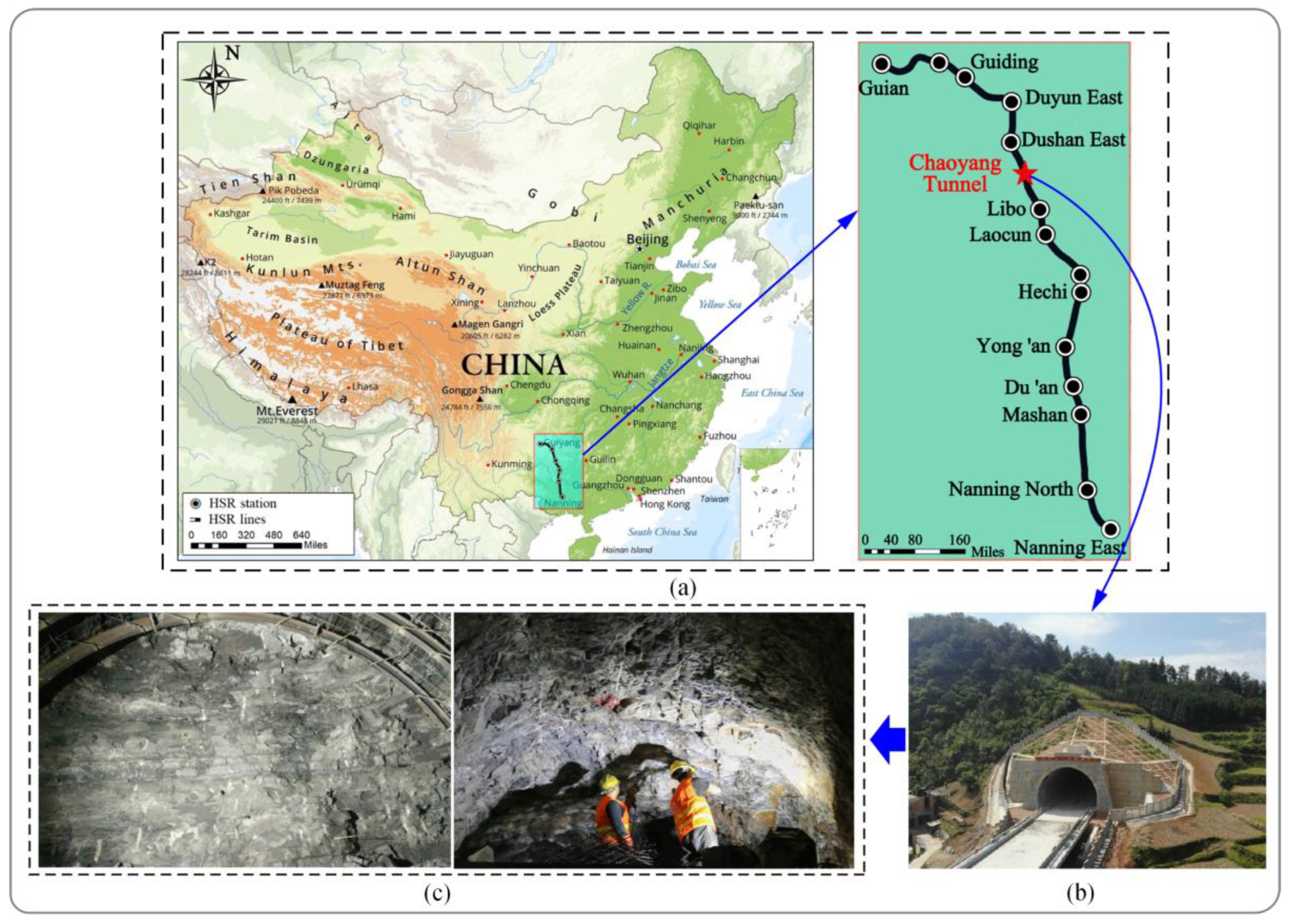
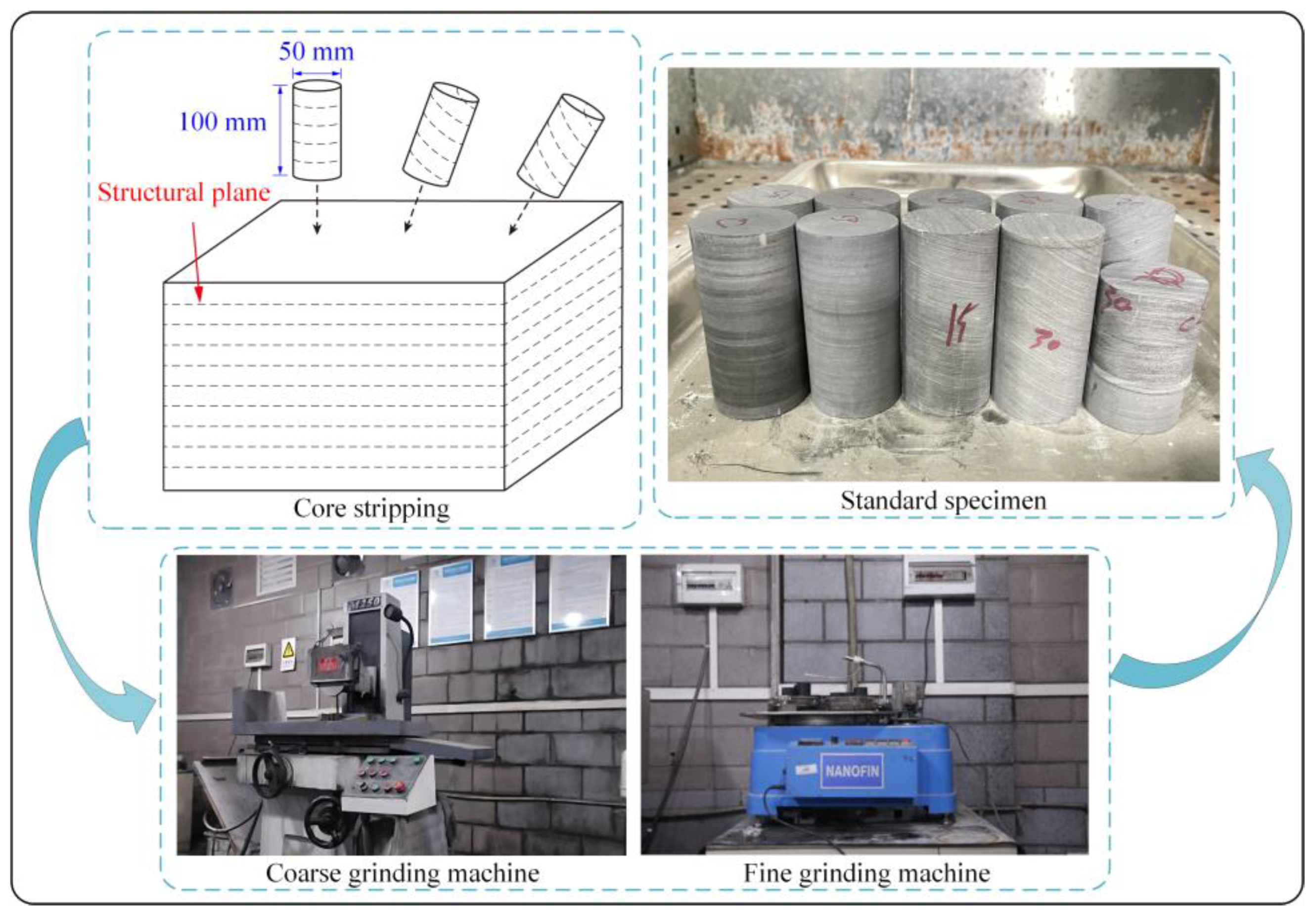

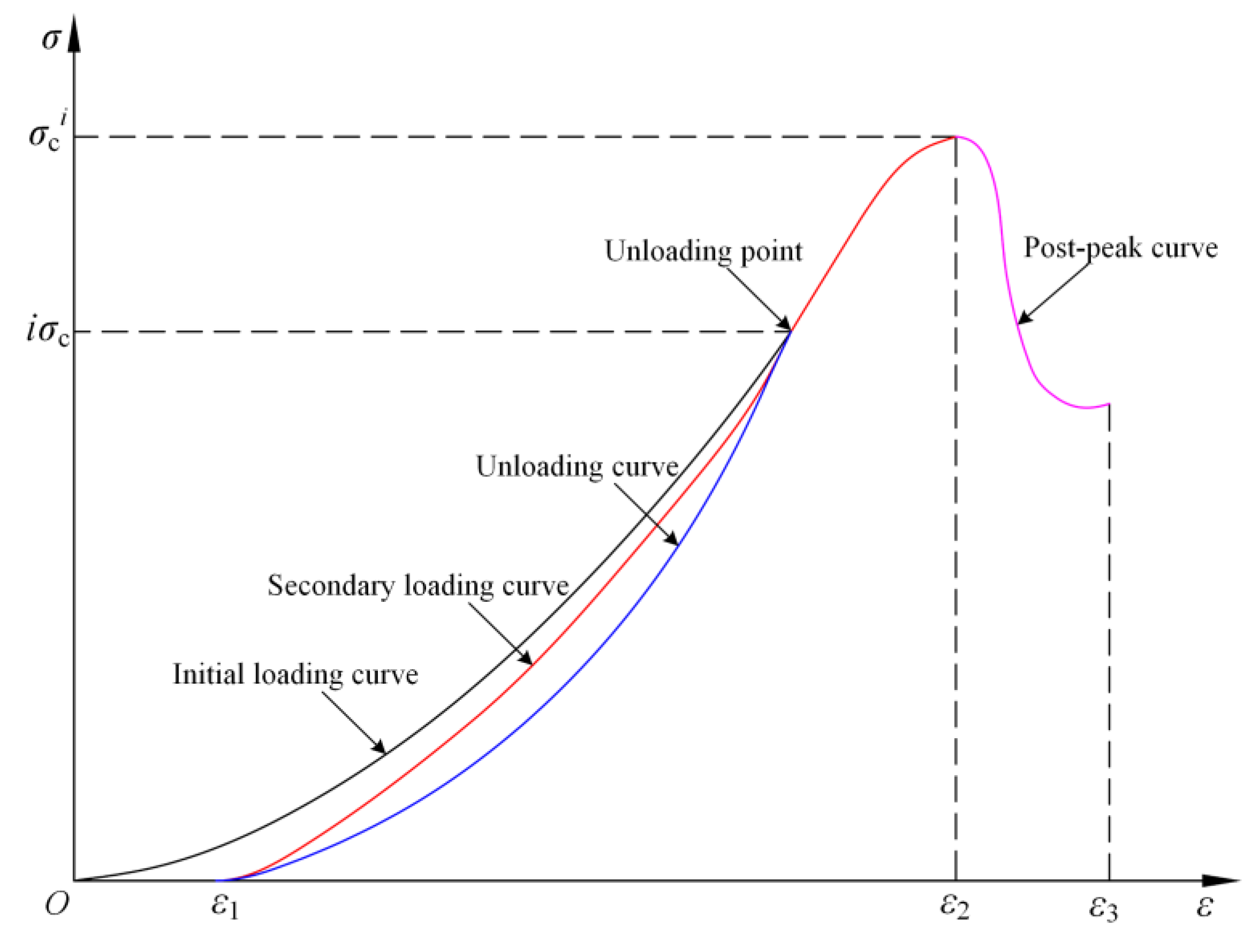
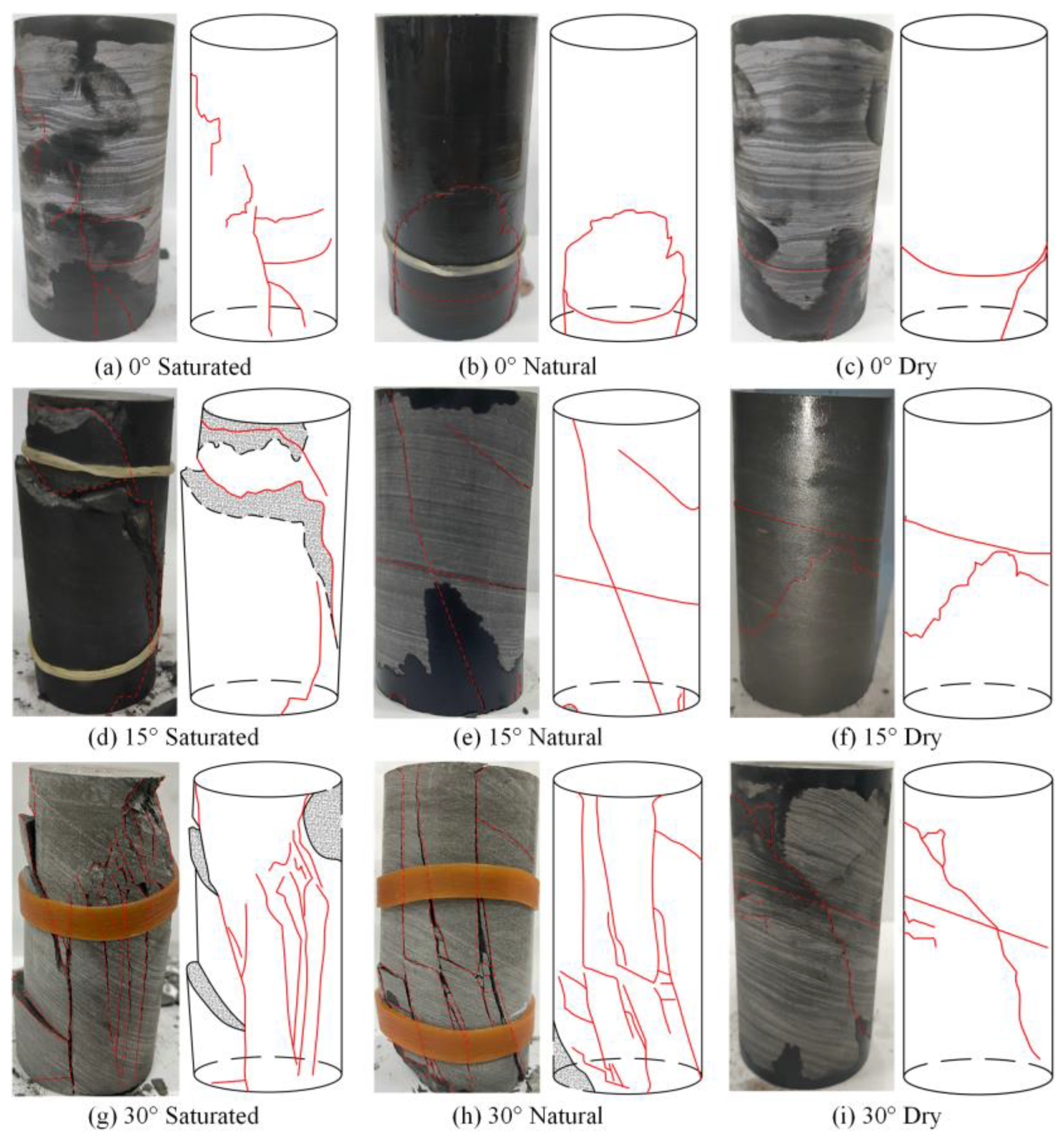
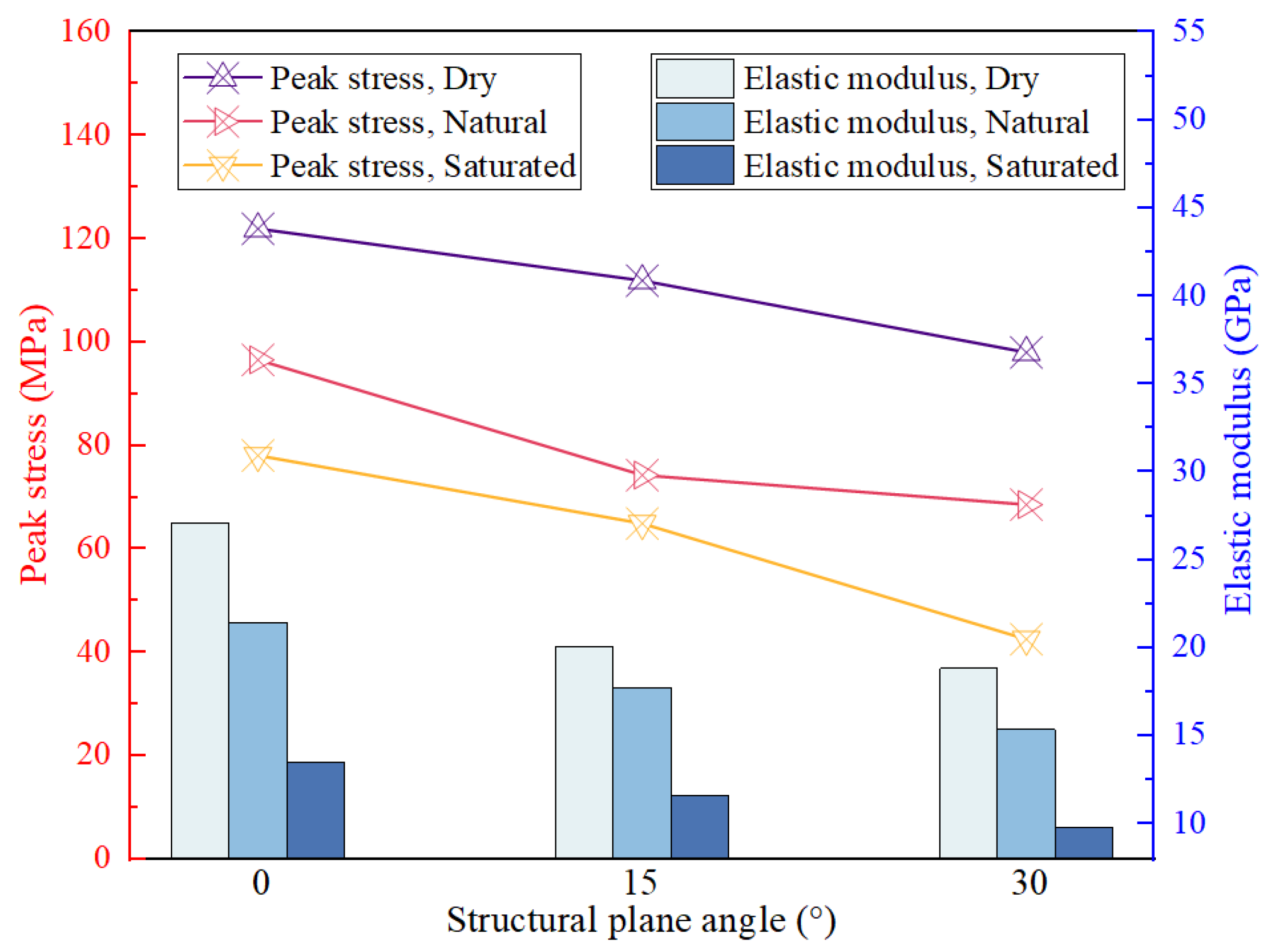

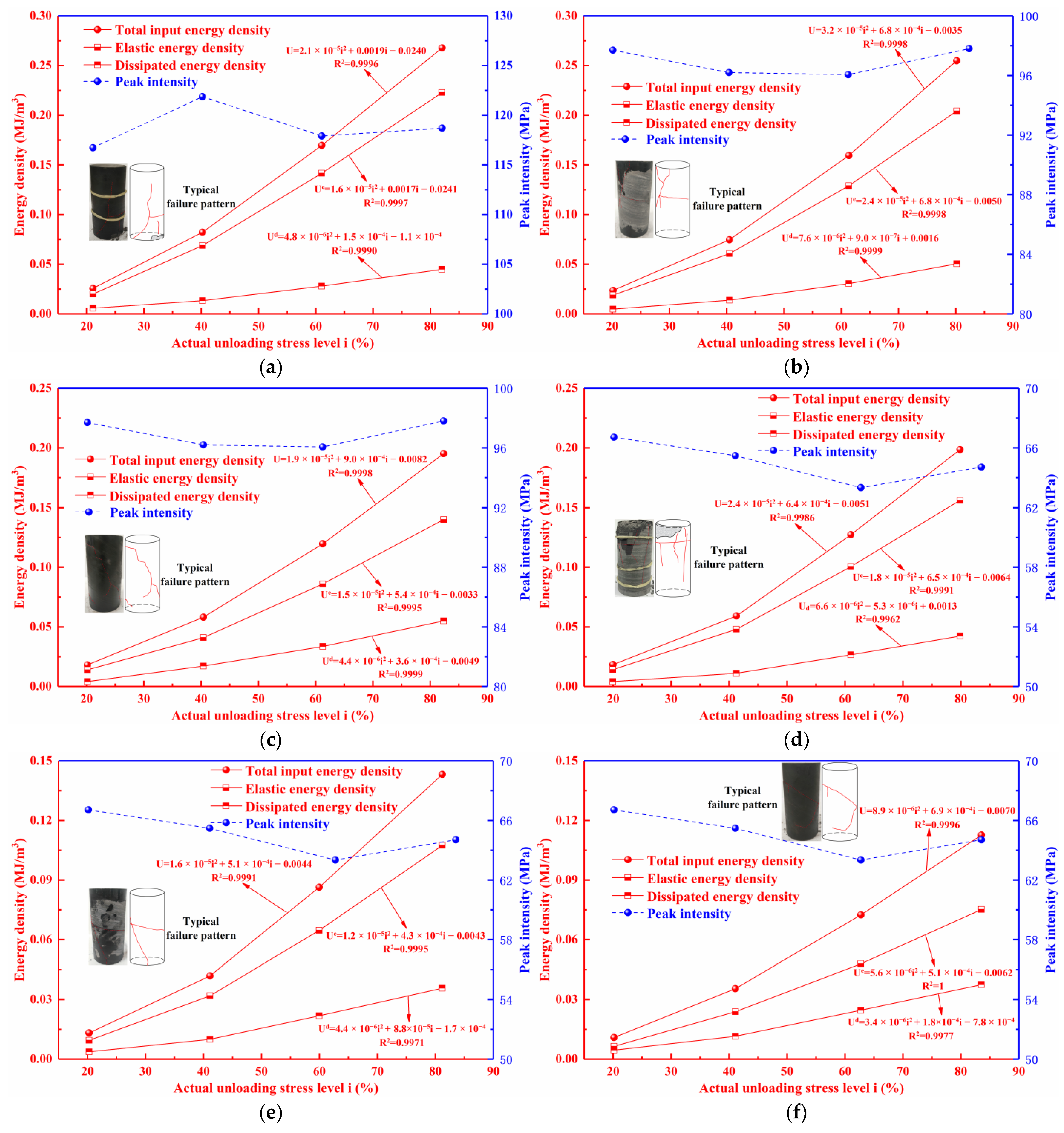
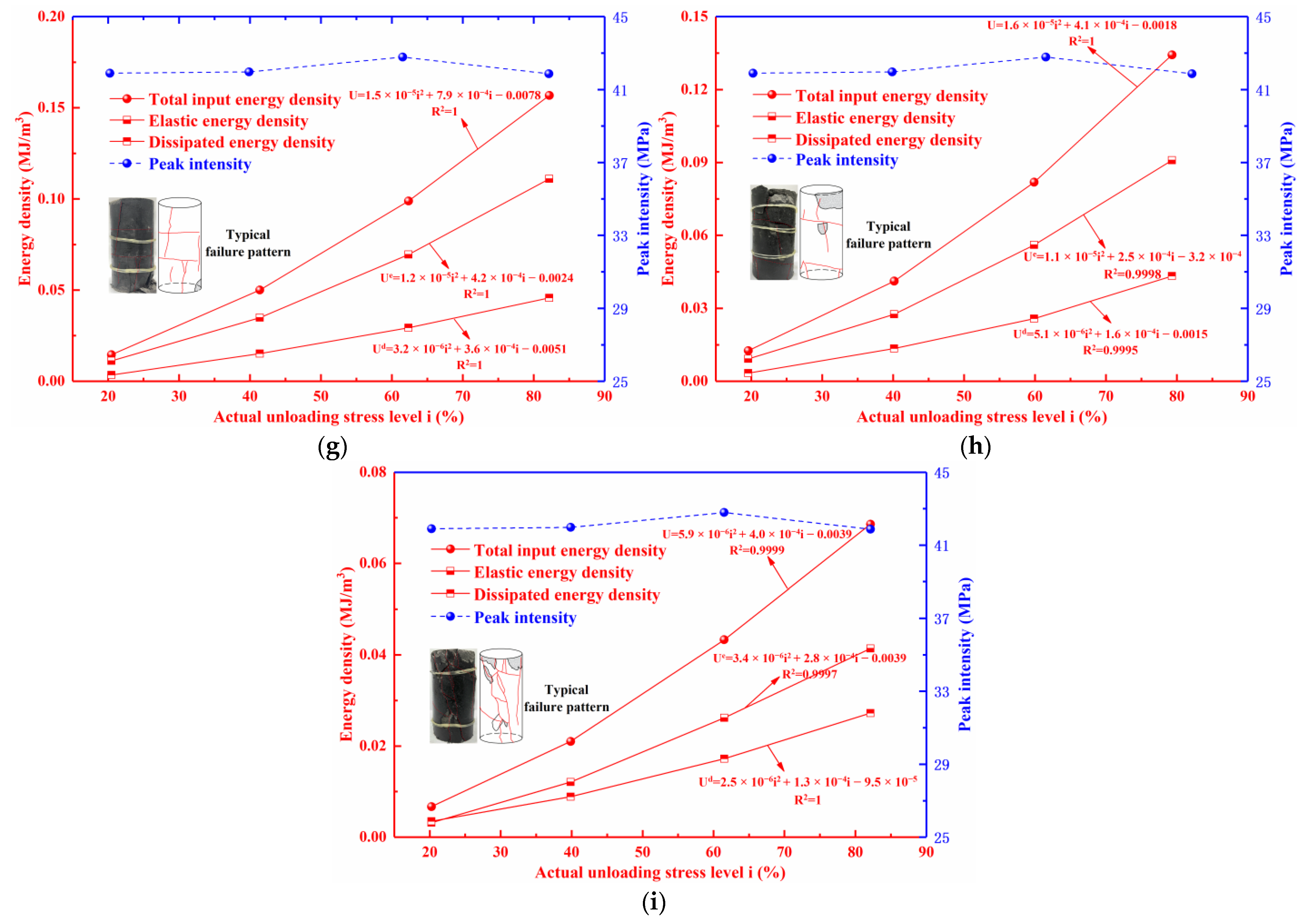
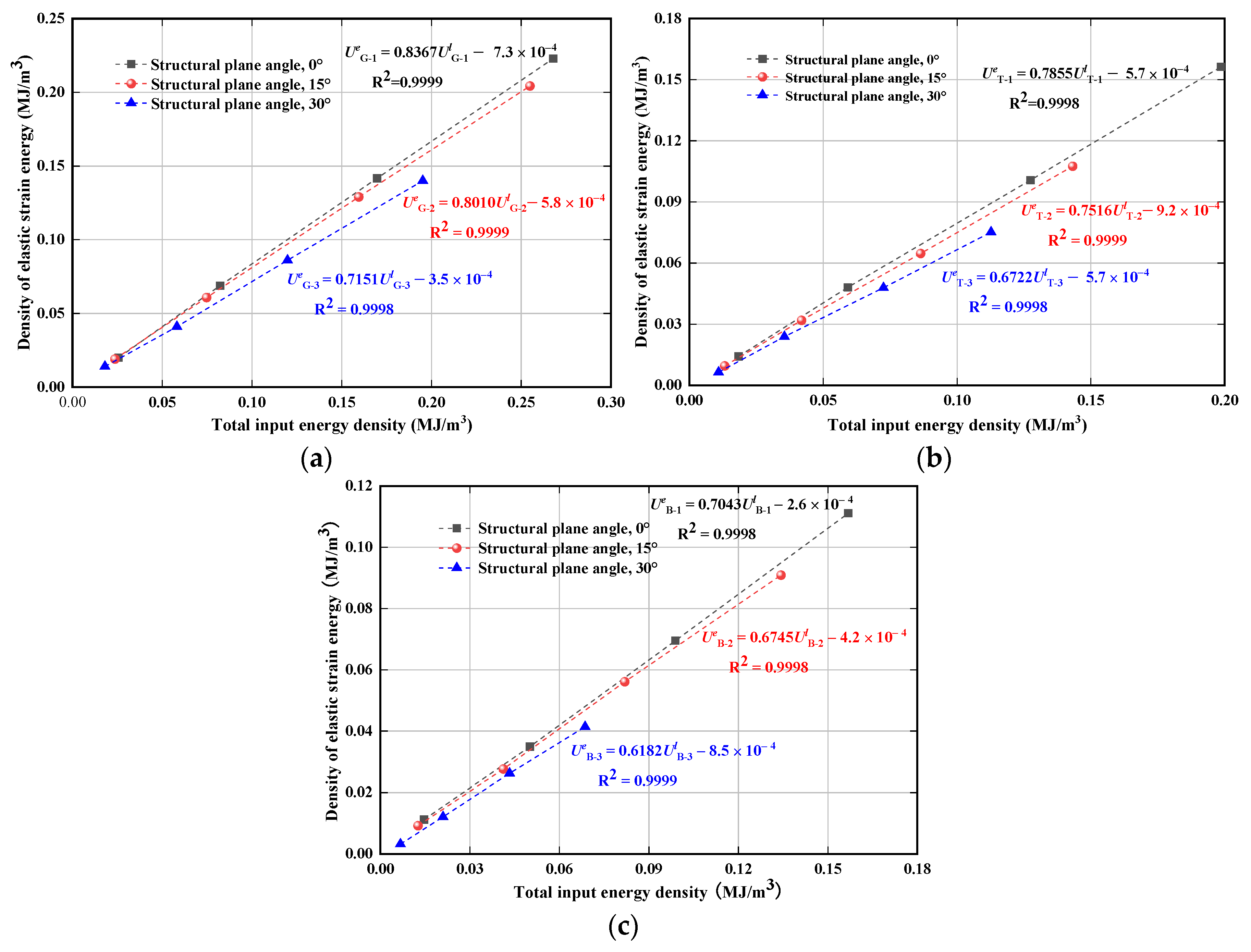
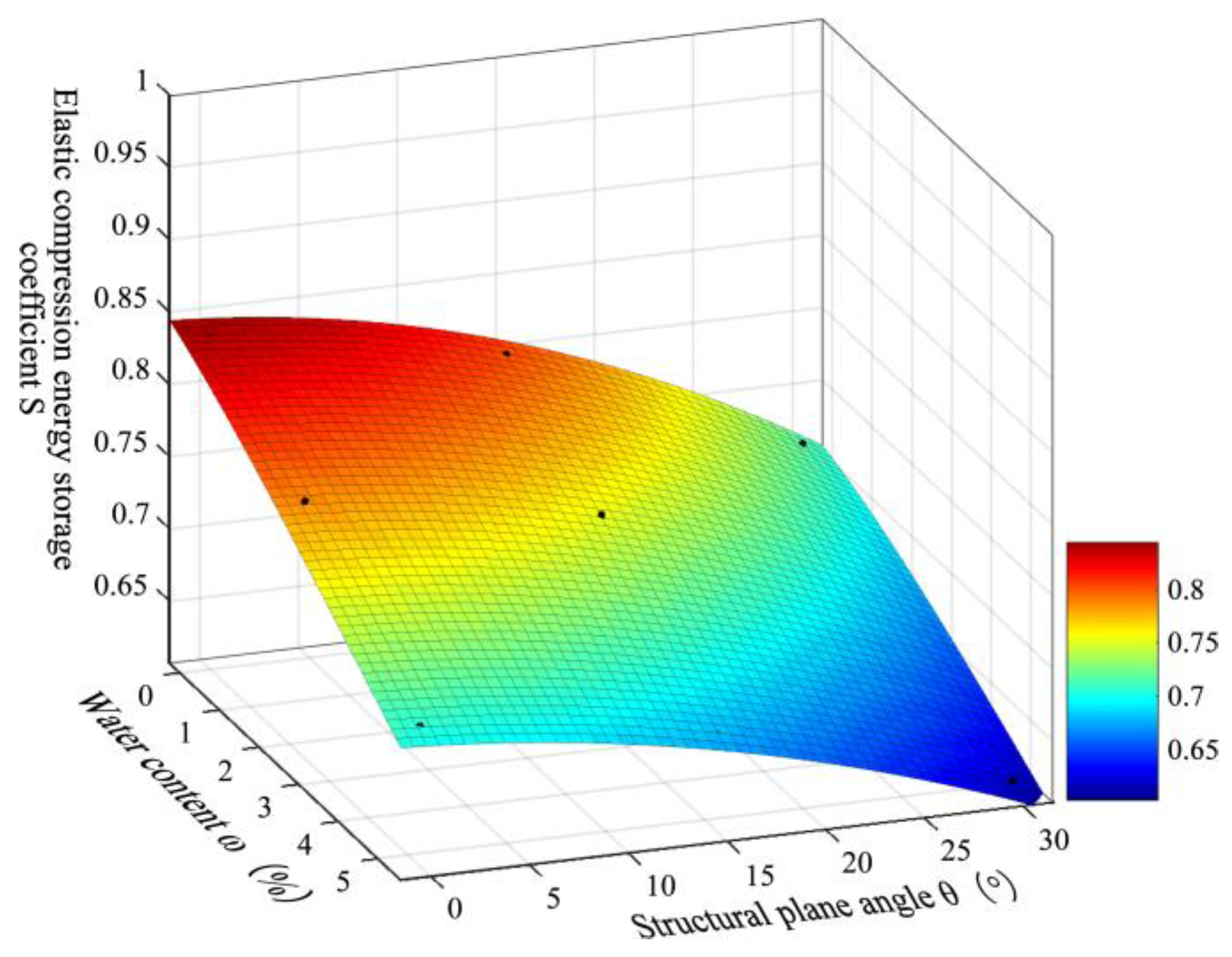
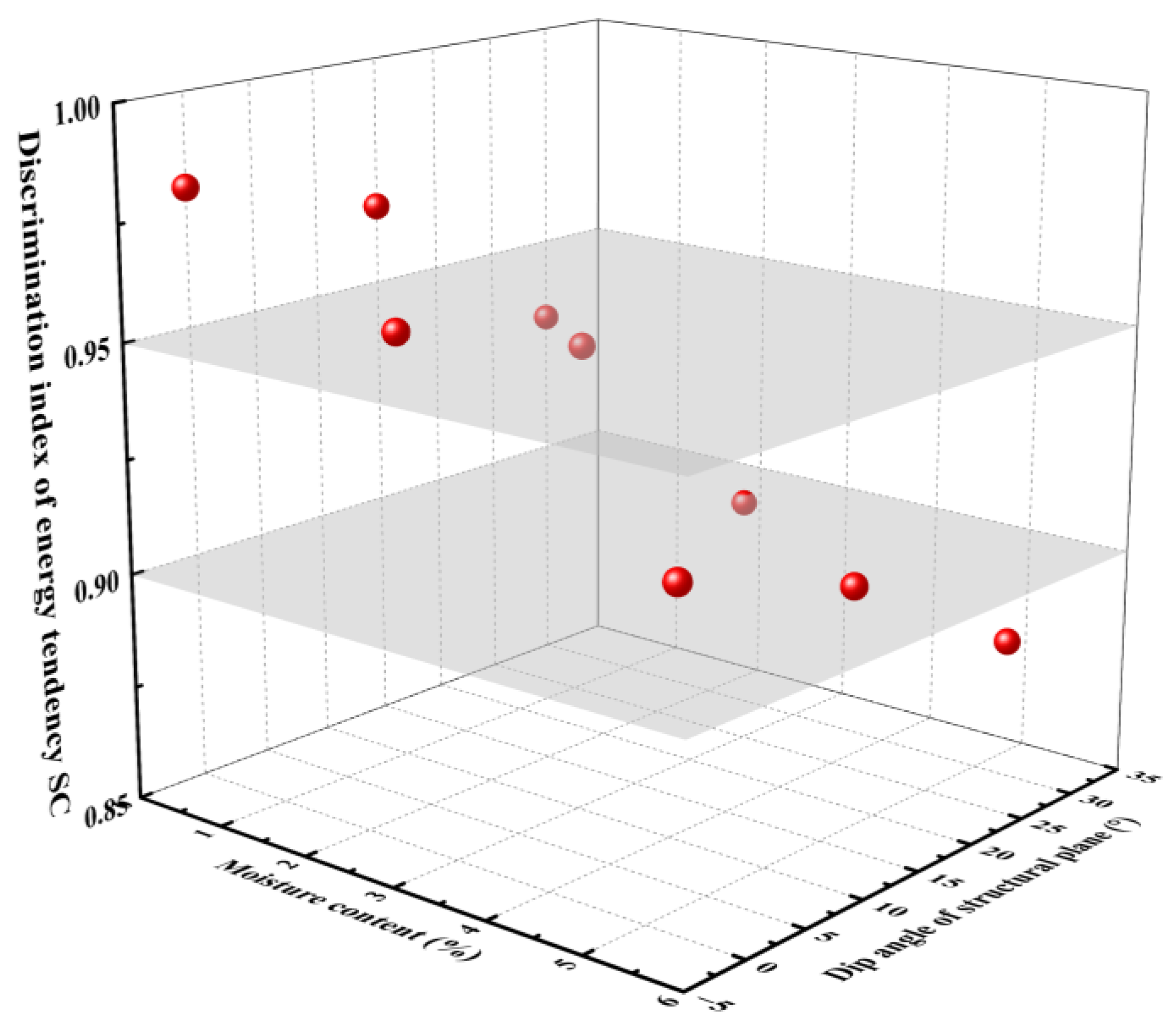
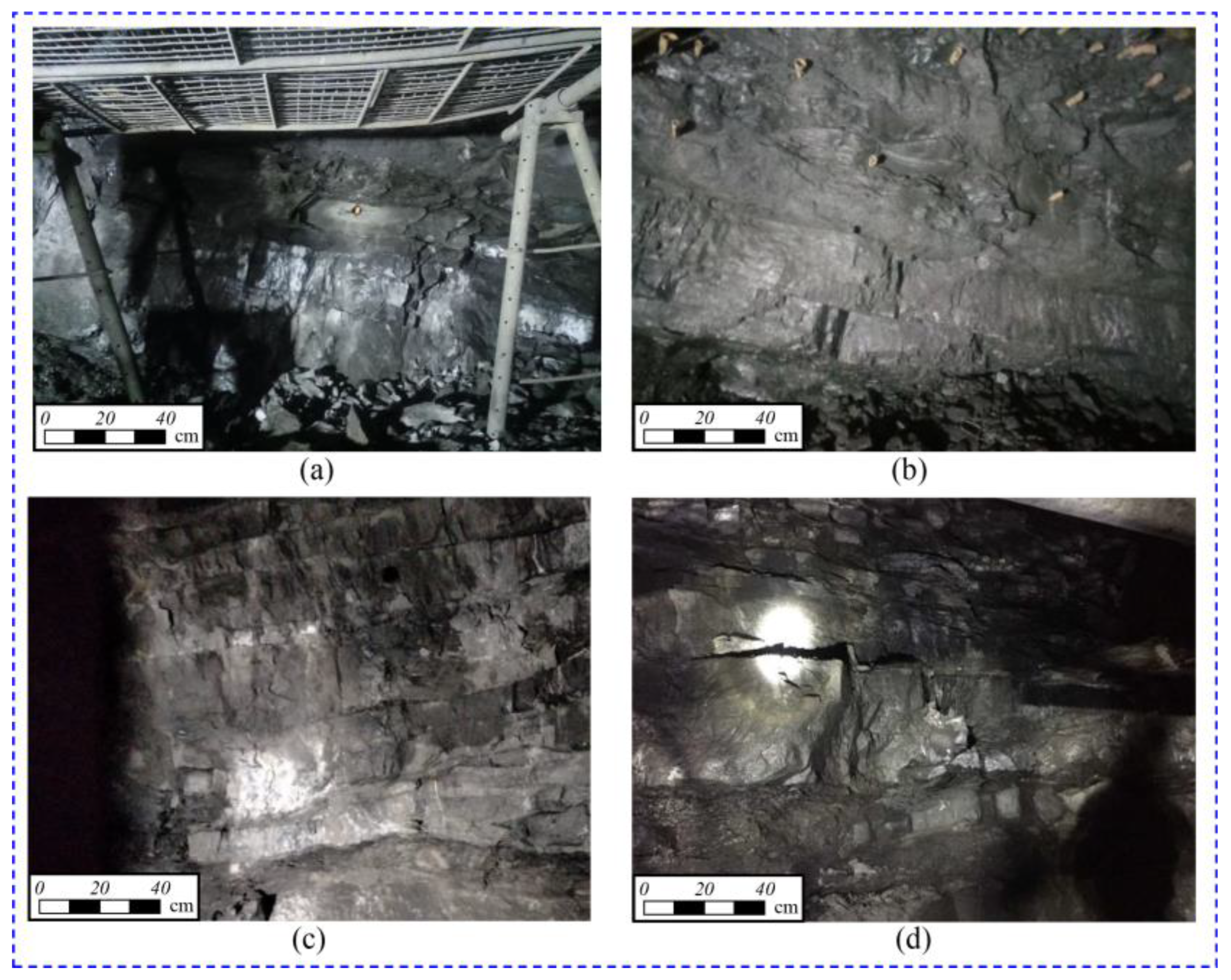
| Specimen No. | Water Content (Wc) | Dip Angle of Structural Plane (Dφ) | Unloading Levels |
|---|---|---|---|
| G-1-i | Dry (0%) | 0° | i = 20%, 40%, 60%, 80% |
| G-2-i | 15° | ||
| G-3-i | 30° | ||
| T-1-i | Natural (2.4%) | 0° | |
| T-2-i | 15° | ||
| T-3-i | 30° | ||
| B-1-i | Saturated (5.3%) | 0° | |
| B-2-i | 15° | ||
| B-3-i | 30° |
| Specimen No. | Water Content (Wc) | Dip Angle of Structural Plane (Dφ) | Elastic Compression Energy Storage Coefficients S |
|---|---|---|---|
| G-1 | 0% | 0° | 0.8367 |
| G-2 | 0% | 15° | 0.8010 |
| G-3 | 0% | 30° | 0.7151 |
| T-1 | 2.4% | 0° | 0.7855 |
| T-2 | 2.4% | 15° | 0.7516 |
| T-3 | 2.4% | 30° | 0.6722 |
| B-1 | 5.3% | 0° | 0.7043 |
| B-2 | 5.3% | 15° | 0.6745 |
| B-3 | 5.3% | 30° | 0.6182 |
| Specimen No. | Elastic Compression Energy Storage Coefficients (S) | Brittle Ductility Index (C) | Indicators of Tunnel Bottom Deformation Tendency (SC) |
|---|---|---|---|
| G-1 | 0.8367 | 0.8763 | 0.9798 |
| G-2 | 0.8010 | 0.8345 | 0.9671 |
| G-3 | 0.7151 | 0.7601 | 0.9317 |
| T-1 | 0.7855 | 0.8072 | 0.9586 |
| T-2 | 0.7516 | 0.7791 | 0.9451 |
| T-3 | 0.6722 | 0.6879 | 0.8977 |
| B-1 | 0.7043 | 0.7358 | 0.9219 |
| B-2 | 0.6745 | 0.7147 | 0.9071 |
| B-3 | 0.6182 | 0.6874 | 0.8806 |
| SC Value | Bottom Deformation Grade | Bottom Deformation (mm) |
|---|---|---|
| SC > 0.95 | I (no deformation) | <100 |
| 0.95 < SC ≤ 0.90 | II (slight deformation) | 100~300 |
| 0.90 < SC ≤ 0.85 | III (moderate deformation) | 300~500 |
| SC < 0.85 | IV (severe deformation) | >500 |
| Section Stake Number | Description of the Basic Conditions | Predicted Values of the Tunnel Bottom Deformation (mm) | Monitoring Values of the Tunnel Bottom Deformation (mm) | SC Value | Determination of the Tunnel Bottom Deformation Degree |
|---|---|---|---|---|---|
| DK166 + 035 | Structural plane angle of 26°, saturated | 300~500 | 369 | 0.8912 (Grade III) | Moderate deformation |
| DK166 + 145 | Structural plane angle of 21°, natural | 100~300 | 241 | 0.9139 (Grade II) | Slight deformation |
| DK166 + 360 | Structural plane angle of 11°, natural | <100 | 91 | 0.9517 (Grade I) | No deformation |
| DK166 + 440 | Structural plane angle of 14°, natural | 100~300 | 152 | 0.9493 (Grade II) | Slight deformation |
Disclaimer/Publisher’s Note: The statements, opinions and data contained in all publications are solely those of the individual author(s) and contributor(s) and not of MDPI and/or the editor(s). MDPI and/or the editor(s) disclaim responsibility for any injury to people or property resulting from any ideas, methods, instructions or products referred to in the content. |
© 2023 by the authors. Licensee MDPI, Basel, Switzerland. This article is an open access article distributed under the terms and conditions of the Creative Commons Attribution (CC BY) license (https://creativecommons.org/licenses/by/4.0/).
Share and Cite
Chen, B.; Tan, Y.; Deng, Y.; Liu, Z.; Meng, W. Experimental Study on Tunnel Bottom Deformation Trend in Gently Inclined Layered Shale Based on the Energy Index. Materials 2023, 16, 7433. https://doi.org/10.3390/ma16237433
Chen B, Tan Y, Deng Y, Liu Z, Meng W. Experimental Study on Tunnel Bottom Deformation Trend in Gently Inclined Layered Shale Based on the Energy Index. Materials. 2023; 16(23):7433. https://doi.org/10.3390/ma16237433
Chicago/Turabian StyleChen, Binke, Yinjun Tan, Yuan Deng, Zheng Liu, and Wei Meng. 2023. "Experimental Study on Tunnel Bottom Deformation Trend in Gently Inclined Layered Shale Based on the Energy Index" Materials 16, no. 23: 7433. https://doi.org/10.3390/ma16237433
APA StyleChen, B., Tan, Y., Deng, Y., Liu, Z., & Meng, W. (2023). Experimental Study on Tunnel Bottom Deformation Trend in Gently Inclined Layered Shale Based on the Energy Index. Materials, 16(23), 7433. https://doi.org/10.3390/ma16237433






